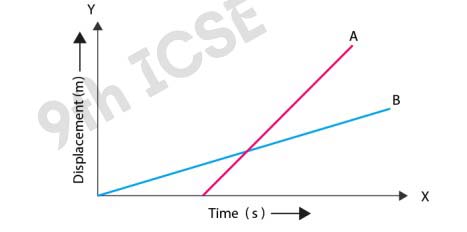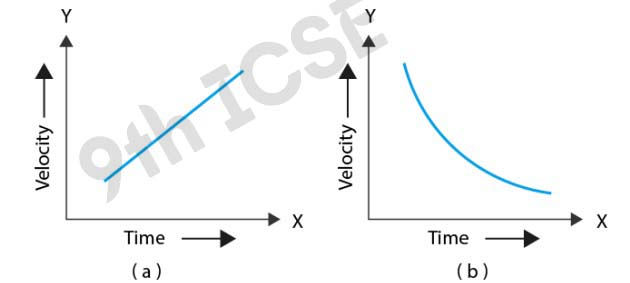Physics Motion in One Dimension Exercise2b
Please Select
Q1 For the motion with uniform velocity, how is the distance travelled related to the time?
Q2 What information about the motion of a body are obtained from the displacement-time graph?
Q3 (a) What does the slope of a displacement-time graph represent?
(b) Can displacement-time sketch be parallel to the displacement axis? Give reason to your answer.
Q4 Draw a displacement-time graph for a boy going to school with a uniform velocity.
Q5 State how the velocity-time graph can be used to find (i) the acceleration of a body, (ii) the distance travelled by the body in a given time, and (iii) the displacement of the body in a given time
Q6 What can you say about the nature of motion of a body if its displacement-time graph is
(a) A straight line parallel to time axis?
(b) A straight line inclined to the time axis with an acute angle?
(c) A straight line inclined to the time axis with an obtuse angle?
(d) A curve
Q7 The figure shows displacement-time graph of two vehicles A and B along a straight road. Which vehicle is moving faster? Give reason.

Q8 State the type of motion represented by the following sketches in the figure. Give example of each type of motion.

Q9 Draw a velocity-time graph for a body moving with an initial velocity u and uniform acceleration a. Use this graph to find the distance travelled by the body in time t.
Q10 What does the slope of velocity-time graph represent?
Q11 Figure shows the velocity-time graph for two cars A and B moving in same direction. Which car has the greater acceleration? Give reason to your answer.

Q12 Draw the shape of the velocity-time graph for a body moving with (a) uniform velocity, (b) uniform acceleration.
Q13 The velocity-time graph for a uniformly retarded body is a straight line inclined to the time axis with an obtuse angle. How is retardation calculated from the velocity-time graph?
Q14 . Figure shows the displacement-time graph for four bodies A, B, C and D. In each case state what information do you get about the acceleration (zero, positive or negative).

Q15 Draw a graph for acceleration against time for a uniformly accelerated motion. How can it be used to find the change in speed in a certain interval of time?
Q16 Draw a velocity-time graph for the free fall of a body under gravity, starting from rest. Take g=10ms-2
Q17 How is the distance related with time for the motion under uniform acceleration such as the motion of a freely falling body?
Q18 A body falls freely from a certain height. Show graphically the relation between the distance fallen and square of time. How will you determine g from this graph?
Multiple Choice type Questions :
Q1 The velocity-time graph of a body in motion is a straight line inclined to the time axis. The correct statement is:
(a) Velocity is uniform
(b) Acceleration is uniform
(c) Both velocity and acceleration are uniform
(d) Neither velocity nor acceleration is uniform
Q2 For a uniformly retarded motion, the velocity-time graph is:
(a) A curve
(b) A straight line parallel to the time axis
(c) A straight line perpendicular to the time axis
(d) A straight line inclined to the time axis
Q3 For the uniform motion:
(a) The distance-time graph is a straight line parallel to the time axis
(b) The speed-time graph is a straight line inclined to the time axis
(c) The speed-time graph is a straight line parallel to the time axis
(d) The acceleration-time graph is a straight line parallel to the time axis.
Contact Us
